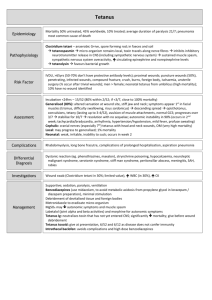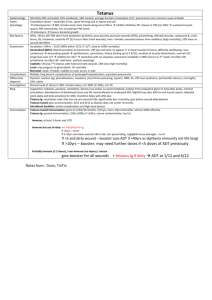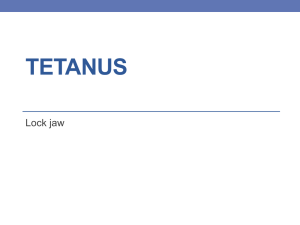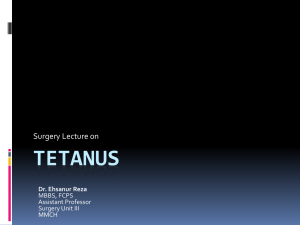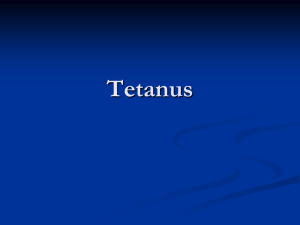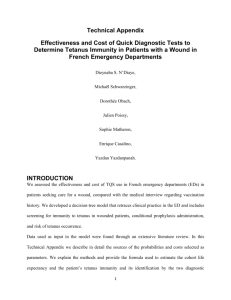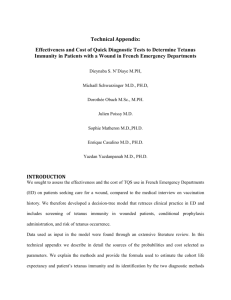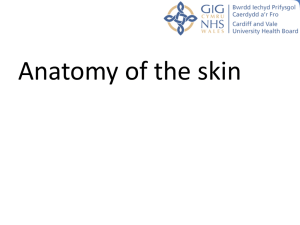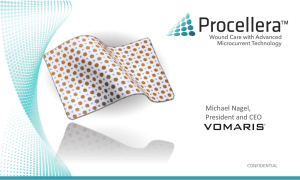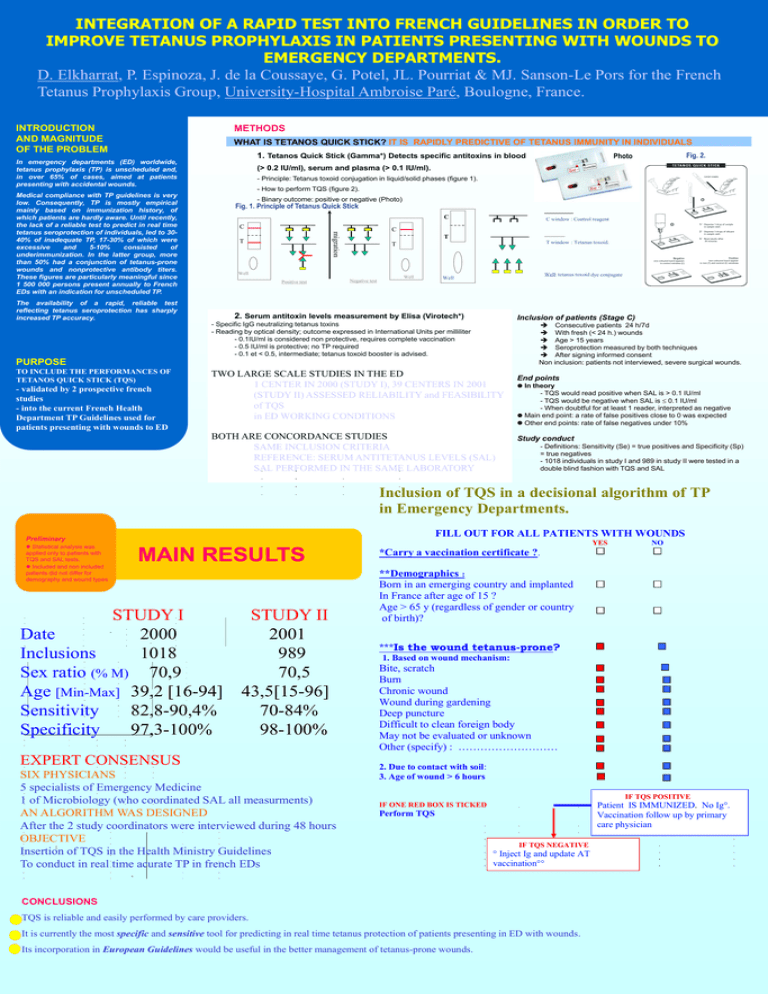
INTEGRATION OF A RAPID TEST INTO FRENCH GUIDELINES IN ORDER TO
IMPROVE TETANUS PROPHYLAXIS IN PATIENTS PRESENTING WITH WOUNDS TO
EMERGENCY DEPARTMENTS.
D. Elkharrat, P. Espinoza, J. de la Coussaye, G. Potel, JL. Pourriat & MJ. Sanson-Le Pors for the French
Tetanus Prophylaxis Group, University-Hospital Ambroise Paré, Boulogne, France.
INTRODUCTION
AND MAGNITUDE
OF THE PROBLEM
METHODS
WHAT IS TETANOS QUICK STICK? IT IS RAPIDLY PREDICTIVE OF TETANUS IMMUNITY IN INDIVIDUALS
(> 0.2 IU/ml), serum and plasma (> 0.1 IU/ml).
- Principle: Tetanus toxoid conjugation in liquid/solid phases (figure 1).
- How to perform TQS (figure 2).
Medical compliance with TP guidelines is very
low. Consequently, TP is mostly empirical
mainly based on immunization history, of
which patients are hardly aware. Until recently,
the lack of a reliable test to predict in real time
tetanus seroprotection of individuals, led to 3040% of inadequate TP, 17-30% of which were
excessive
and
5-10%
consisted
of
underimmunization. In the latter group, more
than 50% had a conjunction of tetanus-prone
wounds and nonprotective antibody titers.
These figures are particularly meaningful since
1 500 000 persons present annually to French
EDs with an indication for unscheduled TP.
- Binary outcome: positive or negative (Photo)
Fig. 1. Principle of Tetanus Quick Stick
C
C
T
T window : Tetanus toxoid.
T
Well
Positive test
C window : Control reagent
C
migration
T
The availability of a rapid, reliable test
reflecting tetanus seroprotection has sharply
increased TP accuracy.
Negative test
Well
Well: tetanus toxoid
- dye conjugate
Well
2. Serum antitoxin levels measurement by Elisa (Virotech*)
Inclusion of patients (Stage C)
- Specific IgG neutralizing tetanus toxins
- Reading by optical density; outcome expressed in International Units per milliliter
- 0.1IU/ml is considered non protective, requires complete vaccination
- 0.5 IU/ml is protective; no TP required
- 0.1 et < 0.5, intermediate; tetanus toxoid booster is advised.
Consecutive patients 24 h/7d
With fresh (< 24 h.) wounds
Age > 15 years
Seroprotection measured by both techniques
After signing informed consent
Non inclusion: patients not interviewed, severe surgical wounds.
PURPOSE
TO INCLUDE THE PERFORMANCES OF
TETANOS QUICK STICK (TQS)
- validated by 2 prospective french
studies
- into the current French Health
Department TP Guidelines used for
patients presenting with wounds to ED
Fig. 2.
Photo
1. Tetanos Quick Stick (Gamma*) Detects specific antitoxins in blood
In emergency departments (ED) worldwide,
tetanus prophylaxis (TP) is unscheduled and,
in over 65% of cases, aimed at patients
presenting with accidental wounds.
TWO LARGE SCALE STUDIES IN THE ED
1 CENTER IN 2000 (STUDY I), 39 CENTERS IN 2001
(STUDY II) ASSESSED RELIABILITY and FEASIBILITY
of TQS
in ED WORKING CONDITIONS
BOTH ARE CONCORDANCE STUDIES
SAME INCLUSION CRITERIA
REFERENCE: SERUM ANTITETANUS LEVELS (SAL)
SAL PERFORMED IN THE SAME LABORATORY
End points
l In theory
- TQS would read positive when SAL is > 0.1 IU/ml
- TQS would be negative when SAL is 0.1 IU/ml
- When doubtful for at least 1 reader, interpreted as negative
l Main end point: a rate of false positives close to 0 was expected
l Other end points: rate of false negatives under 10%
Study conduct
- Definitions: Sensitivity (Se) = true positives and Specificity (Sp)
= true negatives
- 1018 individuals in study I and 989 in study II were tested in a
double blind fashion with TQS and SAL
Inclusion of TQS in a decisional algorithm of TP
in Emergency Departments.
FILL OUT FOR ALL PATIENTS WITH WOUNDS
Preliminary
YES
l Statistical analysis was
applied only to patients with
TQS and SAL tests.
l Included and non included
patients did not differ for
demography and wound types
MAIN RESULTS
STUDY I
Date
2000
Inclusions
1018
Sex ratio (% M) 70,9
Age [Min-Max] 39,2 [16-94]
Sensitivity
82,8-90,4%
Specificity
97,3-100%
-
-
-
STUDY II
2001
989
70,5
43,5[15-96]
70-84%
98-100%
EXPERT CONSENSUS
SIX PHYSICIANS
5 specialists of Emergency Medicine
1 of Microbiology (who coordinated SAL all measurments)
AN ALGORITHM WAS DESIGNED
After the 2 study coordinators were interviewed during 48 hours
OBJECTIVE
:
Insertion of TQS in the Health Ministry Guidelines
To conduct in real time acurate TP in french EDs
NO
*Carry a vaccination certificate ?.
**Demographics :
Born in an emerging country and implanted
In France after age of 15 ?
Age > 65 y (regardless of gender or country
of birth)?
***Is the wound tetanus-prone?
1. Based on wound mechanism:
Bite, scratch
Burn
Chronic wound
Wound during gardening
Deep puncture
Difficult to clean foreign body
May not be evaluated or unknown
Other (specify) : ………………………
2. Due to contact with soil:
3. Age of wound > 6 hours
IF TQS POSITIVE
IF ONE RED BOX IS TICKED
Patient IS IMMUNIZED. No Ig°.
,
Vaccination follow up by primary
care physician
Perform TQS
IF TQS NEGATIVE
° Inject Ig and update AT
vaccination°°
-
CONCLUSIONS
TQS is reliable and easily performed by care providers.
It is currently the most specific and sensitive tool for predicting in real time tetanus protection of patients presenting in ED with wounds.
Its incorporation in European Guidelines would be useful in the better management of tetanus-prone wounds.

